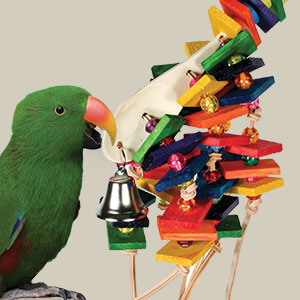
Teaching a Bird to Step Up
Birds are extremely intelligent animals, and they are often capable of being trained. However, teaching them often takes a lot of patience and time. Training is a very important aspect of the owner-bird bonding experience and critical to your relationship. Working with your bird and handling him helps you get to know each other. You will notice his quirks, teach him that you have authority, and better understand his body language and moods. One of the most important training techniques you can teach your bird is the "step up" technique. This technique, which trains your bird to step onto your finger or arm, is the first thing you should teach your bird.
Training tips
If your bird is new and you have not handled him before, first let him become accustomed to your hand and fingers. Don't touch him at first; as he becomes acclimated to your hand, let him perch on your finger. While you're doing this, make sure that you keep your head above his eye level, but not too high that he is scared of you. If you lower your head below his, he might think he is superior to you and not obey your commands.Patience is key when starting to work with your bird, so if you're in an impatient mood, wait until later to work with your bird. If your bird is large or has a tendency to bite, use a dowel in place of your hand in the training process. Keep your training sessions short (around 10 to 15 minutes) and try to train at the same time every day so that your bird establishes a routine. Train in a quiet room to avoid distractions.
How to start
When your bird becomes comfortable with you, you can start with easy training techniques. For the "step up" technique, hold out your finger and press it gently against his breast right above his legs. As you're doing this, say "step up." Make sure that you keep your wrist, hand, or perch steady; your confidence or lack of confidence will rub off on your bird. Be aware that some birds might use their beaks to help them step up. If you suddenly pull away or yell, your bird might bite you.Because your finger resembles a perch, there is something instinctual about stepping up. If he doesn't step up on your finger, you can present him with a treat to entice him to step up. Positive reinforcement is key in training. Rewarding him with a lot of praise each time he accomplishes this task will encourage him to continue obeying the command.
Training should always be a fun and positive time for your bird. If you are patient, consistent, and encouraging, you will often be rewarded in return!
Discover More!
How to Train a Bird Using Positive ReinforcementReturn to Bird Articles


